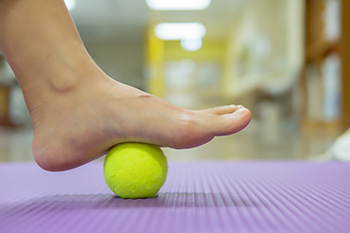Connect With Us
Blog
Items filtered by date: September 2022
Frequent High Heel Use May Cause Foot Conditions

People who frequently wear high heels may not realize the dangers that coincide, beginning with an increase in tripping hazards. Additionally, high heels may significantly contribute to incurring a foot or ankle injury, and circulation may be negatively affected, too. Some of the foot conditions that can gradually develop from wearing high heels include Achilles tendonitis, bunions, hammertoes, blisters, corns, and calluses. The body’s weight can be affected by leaning forward as a result of the shape of the shoe and this can cause the weight to shift to the balls of the feet. Some measures can be implemented that can provide comfort while wearing high heels. These can include choosing a lower heel, wearing them less often during the week, and stretching the feet and ankles as often as possible. Podiatrists can answer any questions you may have regarding how high heels can affect the feet, and it is suggested that you consult with this type of doctor if you would like more information.
High heels have a history of causing foot and ankle problems. If you have any concerns about your feet or ankles, contact one of our podiatrists from Crosstown Podiatry. Our doctors can provide the care you need to keep you pain-free and on your feet.
Effects of High Heels on the Feet
High heels are popular shoes among women because of their many styles and societal appeal. Despite this, high heels can still cause many health problems if worn too frequently.
Which Parts of My Body Will Be Affected by High Heels?
- Ankle Joints
- Achilles Tendon – May shorten and stiffen with prolonged wear
- Balls of the Feet
- Knees – Heels cause the knees to bend constantly, creating stress on them
- Back – They decrease the spine’s ability to absorb shock, which may lead to back pain. The vertebrae of the lower back may compress.
What Kinds of Foot Problems Can Develop from Wearing High Heels?
- Corns
- Calluses
- Hammertoe
- Bunions
- Morton’s Neuroma
- Plantar Fasciitis
How Can I Still Wear High Heels and Maintain Foot Health?
If you want to wear high heeled shoes, make sure that you are not wearing them every day, as this will help prevent long term physical problems. Try wearing thicker heels as opposed to stilettos to distribute weight more evenly across the feet. Always make sure you are wearing the proper shoes for the right occasion, such as sneakers for exercising. If you walk to work, try carrying your heels with you and changing into them once you arrive at work. Adding inserts to your heels can help cushion your feet and absorb shock. Full foot inserts or metatarsal pads are available.
If you have any questions please feel free to contact our offices located in Wayne, Montclair, and Randolph, NJ . We offer the newest diagnostic and treatment technologies for all your foot and ankle needs.
Shoe Shopping In-Store

If you are a runner, you are undoubtedly familiar with the importance of selecting the right kind of running shoe. While shopping for your first pair of running shoes on the internet might be convenient and fast, you may consider shopping for that first pair in an actual store. When visiting a store (such as a specialty running shop), it might be possible for you to receive a gait analysis, which can help you identify exactly what features your shoes should have. Additionally, since selecting the right running shoe is all about finding the correct fit, being physically in the store can make it easier for you to try on a variety of different sizes that first time. This can also help you identify which brands of running shoes tend to run smaller or larger compared to others. Lastly, shopping in the actual store will enable you to take any orthotics that you use with you and try them out in potential running shoes. If you have any more questions about picking running shoes, contact a podiatrist.
If you are a runner, wearing the right running shoe is essential. For more information, contact one of our podiatrists from Crosstown Podiatry. Our doctors can provide the care you need to keep you pain-free and on your feet.
Choosing the Right Running Shoe for Your Foot Type
To increase performance and avoid the risk of injury, it is important to choose the right running shoe based on your foot type. The general design of running shoes revolves around pronation, which is how the ankle rolls from outside to inside when the foot strikes the ground.
- Neutral runners are able to choose from a wide variety of shoes, including minimalist shoes or even going barefoot.
- Runners who overpronate, or experience an over-abundance of ankle rolling, should choose shoes that provide extra motion control and stability.
- Runners who underpronate, or supinate, have feet that have high arches and lack flexibility, preventing shock absorption. They require shoes with more flexibility and cushion.
If you have any questions please feel free to contact our offices located in Wayne, Montclair, and Randolph, NJ . We offer the newest diagnostic and treatment technologies for all your foot and ankle needs.
Surgery for Ankle Fractures

An individual can break or fracture their ankle by experiencing different kinds of trauma, such as twisting ankle movements or injuries. If you have a fractured ankle, it is possible that the fracture is partial or complete in the affected bone. Additionally, the fracture may have developed where the ligament has been impacted. Sometimes, a medical professional will recommend undergoing a surgical procedure to treat a broken or fractured ankle if they believe that the injury will heal best with surgery. Particularly, if the fracture has spread to the joint in the ankle, a medical professional may recommend surgery. After undergoing a surgical procedure to treat a broken ankle, you may need to wear some sort of cast or splint for an extended period of time. This is largely dependent on the severity of your injury. You may also be instructed to limit the extent to which you put weight on the affected ankle. It is also possible that to continue to be mobile, you may have to use crutches following the surgery. If you have a broken ankle, contact a podiatrist who can assess your situation and discuss your options.
Broken ankles need immediate treatment. If you are seeking treatment, contact one of our podiatrists from Crosstown Podiatry. Our doctors can provide the care you need to keep you pain-free and on your feet.
Broken Ankles
A broken ankle is experienced when a person fractures their tibia or fibula in the lower leg and ankle area. Both of these bones are attached at the bottom of the leg and combine to form what we know to be our ankle.
When a physician is referring to a break of the ankle, he or she is usually referring to a break in the area where the tibia and fibula are joined to create our ankle joint. Ankles are more prone to fractures because the ankle is an area that suffers a lot of pressure and stress. There are some obvious signs when a person experiences a fractured ankle, and the following symptoms may be present.
Symptoms of a Fractured Ankle
- Excessive pain when the area is touched or when any pressure is placed on the ankle
- Swelling around the area
- Bruising of the area
- Area appears to be deformed
If you suspect an ankle fracture, it is recommended to seek treatment as soon as possible. The sooner you have your podiatrist diagnose the fracture, the quicker you’ll be on the way towards recovery.
If you have any questions, please feel free to contact our offices located in Wayne, Montclair, and Randolph, NJ . We offer the newest diagnostic and treatment technologies for all your foot care needs.
Stretching the Feet Before a Workout

Before an individual begins their exercise routine, they may briefly stretch their neck, arms, and legs. It is undoubtedly important to ensure that these body parts are loose and limber. However, stretching out the feet before an exercise routine is just as important. This is because foot pain, injuries, and afflictions developed from not stretching can make it difficult to continue working out the next day. If an individual properly stretches or warms up their feet before a workout, other parts of the body may benefit. For example, depending on the stretch, the calves, hamstrings, and shins might benefit from foot stretches. Before a workout, you might consider performing the tiptoe walk. This stretch can be performed by standing on your tiptoes and walking on an exercise mat for about thirty seconds or so. Some individuals who perform this pre-workout stretch might notice increased ankle stability. When stretching, it is always important to listen to your body and never push or strain your body. If you are someone who works out frequently and has always neglected stretching the feet, contact a podiatrist. They will be able to help you with more information about stretching your feet.
Exercising your feet regularly with the proper foot wear is a great way to prevent injuries and build strength. If you have any concerns about your feet, contact one of our podiatrists from Crosstown Podiatry. Our doctors can provide the care you need to keep you pain-free and on your feet.
Exercise for Your Feet
Exercise for your feet can help you gain strength, mobility and flexibility in your feet. They say that strengthening your feet can be just as rewarding as strengthening another part of the body. Your feet are very important, and we often forget about them in our daily tasks. But it is because of our feet that are we able to get going and do what we need to. For those of us fortunate enough to not have any foot problems, it is an important gesture to take care of them to ensure good health in the long run.
Some foot health exercises can include ankle pumps, tip-toeing, toe rises, lifting off the floor doing reps and sets, and flexing the toes. It is best to speak with Our doctors to determine an appropriate regimen for your needs. Everyone’s needs and bodies are different, and the activities required to maintain strength in the feet vary from individual to individual.
Once you get into a routine of doing regular exercise, you may notice a difference in your feet and how strong they may become.
If you have any questions please feel free to contact our offices located in Wayne, Montclair, and Randolph, NJ . We offer the newest diagnostic and treatment technologies for all your foot and ankle needs.

